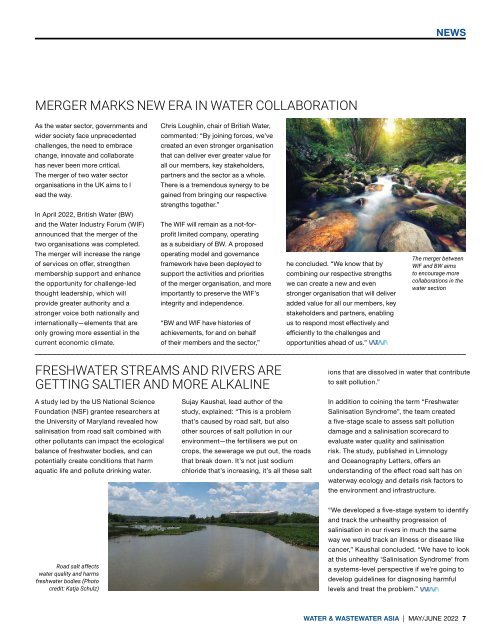Water & Wastewater Asia May/June 2022
Water & Wastewater Asia is an expert source of industry information, cementing its position as an indispensable tool for trade professionals in the water and wastewater industry. As the most reliable publication in the region, industry experts turn this premium journal for credible journalism and exclusive insight provided by fellow industry professionals. Water & Wastewater Asia incorporates the official newsletter of the Singapore Water Association (SWA).
Water & Wastewater Asia is an expert source of industry information, cementing its position as an indispensable tool for trade professionals in the water and wastewater industry. As the most reliable publication in the region, industry experts turn this premium journal for credible journalism and exclusive insight provided by fellow industry professionals. Water & Wastewater Asia incorporates the official newsletter of the Singapore Water Association (SWA).
You also want an ePaper? Increase the reach of your titles
YUMPU automatically turns print PDFs into web optimized ePapers that Google loves.
NEWS<br />
MERGER MARKS NEW ERA IN WATER COLLABORATION<br />
As the water sector, governments and<br />
wider society face unprecedented<br />
challenges, the need to embrace<br />
change, innovate and collaborate<br />
has never been more critical.<br />
The merger of two water sector<br />
organisations in the UK aims to l<br />
ead the way.<br />
In April <strong>2022</strong>, British <strong>Water</strong> (BW)<br />
and the <strong>Water</strong> Industry Forum (WIF)<br />
announced that the merger of the<br />
two organisations was completed.<br />
The merger will increase the range<br />
of services on offer, strengthen<br />
membership support and enhance<br />
the opportunity for challenge-led<br />
thought leadership, which will<br />
provide greater authority and a<br />
stronger voice both nationally and<br />
internationally—elements that are<br />
only growing more essential in the<br />
current economic climate.<br />
Chris Loughlin, chair of British <strong>Water</strong>,<br />
commented: “By joining forces, we’ve<br />
created an even stronger organisation<br />
that can deliver ever greater value for<br />
all our members, key stakeholders,<br />
partners and the sector as a whole.<br />
There is a tremendous synergy to be<br />
gained from bringing our respective<br />
strengths together.”<br />
The WIF will remain as a not-forprofit<br />
limited company, operating<br />
as a subsidiary of BW. A proposed<br />
operating model and governance<br />
framework have been deployed to<br />
support the activities and priorities<br />
of the merger organisation, and more<br />
importantly to preserve the WIF’s<br />
integrity and independence.<br />
“BW and WIF have histories of<br />
achievements, for and on behalf<br />
of their members and the sector,”<br />
he concluded. “We know that by<br />
combining our respective strengths<br />
we can create a new and even<br />
stronger organisation that will deliver<br />
added value for all our members, key<br />
stakeholders and partners, enabling<br />
us to respond most effectively and<br />
efficiently to the challenges and<br />
opportunities ahead of us.”<br />
The merger between<br />
WIF and BW aims<br />
to encourage more<br />
collaborations in the<br />
water section<br />
FRESHWATER STREAMS AND RIVERS ARE<br />
GETTING SALTIER AND MORE ALKALINE<br />
ions that are dissolved in water that contribute<br />
to salt pollution.”<br />
A study led by the US National Science<br />
Foundation (NSF) grantee researchers at<br />
the University of Maryland revealed how<br />
salinisation from road salt combined with<br />
other pollutants can impact the ecological<br />
balance of freshwater bodies, and can<br />
potentially create conditions that harm<br />
aquatic life and pollute drinking water.<br />
Sujay Kaushal, lead author of the<br />
study, explained: “This is a problem<br />
that’s caused by road salt, but also<br />
other sources of salt pollution in our<br />
environment—the fertilisers we put on<br />
crops, the sewerage we put out, the roads<br />
that break down. It’s not just sodium<br />
chloride that’s increasing, it’s all these salt<br />
In addition to coining the term “Freshwater<br />
Salinisation Syndrome”, the team created<br />
a five-stage scale to assess salt pollution<br />
damage and a salinisation scorecard to<br />
evaluate water quality and salinisation<br />
risk. The study, published in Limnology<br />
and Oceanography Letters, offers an<br />
understanding of the effect road salt has on<br />
waterway ecology and details risk factors to<br />
the environment and infrastructure.<br />
Road salt affects<br />
water quality and harms<br />
freshwater bodies (Photo<br />
credit: Katja Schulz)<br />
“We developed a five-stage system to identify<br />
and track the unhealthy progression of<br />
salinisation in our rivers in much the same<br />
way we would track an illness or disease like<br />
cancer,” Kaushal concluded. “We have to look<br />
at this unhealthy ‘Salinisation Syndrome’ from<br />
a systems-level perspective if we’re going to<br />
develop guidelines for diagnosing harmful<br />
levels and treat the problem.”<br />
WATER & WASTEWATER ASIA | MAY/JUNE <strong>2022</strong> 7


















